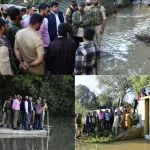DON’ MESS WITH THE NATRURE
The deadly cloudburst in Kishtwar, which claimed over 50 lives and left scores injured or missing, has once again brought into sharp focus the vulnerability of Jammu and Kashmir’s Himalayan region to extreme weather events. For the residents of this mountainous terrain, disasters like flash floods, landslides, avalanches and now increasingly frequent cloudbursts are no longer rare occurrences — they are becoming part of life’s unpredictable rhythm.
The day the disaster struck in Kishtwar will be etched forever in the memory of survivors. In a matter of minutes, the roar of rushing water, rocks and mud swallowed homes, farmlands and everything in its path. Eyewitnesses described a terrifying scene where there was no time to react, no safe space to run, and no chance to salvage belongings. Nature’s fury, unleashed in such sudden force, leaves little room for preparedness in the moment. But on a broader scale, the question remains — are we doing enough to prepare for such events before they strike?
The Himalayas in J&K are young mountains, still rising and shifting due to tectonic activity. This geological youth makes them naturally unstable. Add to this the effects of climate change, deforestation, unregulated construction, and unchecked quarrying, and you have a recipe for heightened disaster risk. The steep slopes of the region, combined with fragile soil and loose rock formations, mean that intense rainfall can easily trigger landslides and flash floods. A cloudburst, which can dump several centimetres of rain in just an hour over a small area, exerts extraordinary pressure on the landscape — and on the people who live there.
Experts have repeatedly pointed out that climate change is altering the rainfall patterns in the Himalayas. Where once the region experienced steady monsoon rains spread over weeks, now we see sudden, intense downpours. Rising global temperatures have also led to accelerated glacial melt, swelling rivers and streams during the summer months. When these swollen waterways are suddenly hit by a cloudburst, the destructive potential multiplies.
Kishtwar is not unfamiliar with such calamities. Its rugged terrain, remote villages and limited infrastructure make disaster response especially challenging. Rescue teams, even when mobilised quickly, often face blocked roads, broken bridges, and hostile weather conditions. In the most recent tragedy, the Army, NDRF and local volunteers worked tirelessly, but reaching the affected areas took precious hours — hours that, in such events, often mean the difference between life and death.
The question now is not just about rescue and relief, but about prevention and preparedness. The first step lies in strengthening our early warning systems. While meteorological departments have improved their forecasting abilities, cloudbursts are still difficult to predict with precision due to their highly localized nature. However, installing more weather radars in mountainous regions, combined with real-time satellite monitoring, can help detect the early signs of intense convection that leads to cloudbursts. Timely alerts sent directly to residents’ phones, even minutes before an event, could save lives.
Equally important is sustainable land use. Over the years, many slopes in J&K have been stripped of their natural vegetation to make way for agriculture, roads or housing. Trees and shrubs play a crucial role in stabilizing soil and slowing down water runoff. Deforestation not only weakens slope stability but also reduces the land’s ability to absorb rainfall, making flash floods more likely. Afforestation and soil conservation programmes must be prioritised, and indiscriminate construction in vulnerable zones strictly regulated.
Infrastructure resilience is another key aspect. In the Himalayas, roads, bridges, and buildings are often built without considering the full scale of disaster risks. Engineering designs must account for the possibility of extreme events like cloudbursts and earthquakes. This includes building retaining walls, proper drainage systems, and flood-resistant housing. Importantly, no development should take place on riverbanks and floodplains, which are natural high-risk zones.
Community awareness and training are equally vital. People living in vulnerable areas should be educated on how to respond when a disaster strikes. Simple measures — such as identifying safe evacuation routes, storing emergency kits, and conducting mock drills — can make a big difference. In many parts of the world, community-led disaster response teams have saved countless lives, and J&K can learn from these examples.
Long-term, the government and scientific community must work together on detailed hazard mapping of the Himalayan region. Identifying the most at-risk zones, monitoring glacial lakes for sudden bursts and tracking shifting river courses will help in planning safer settlements and infrastructure.
The tragedy in Kishtwar is also a reminder of the human cost of environmental neglect. While we cannot stop natural phenomena like cloudbursts, we can certainly reduce their impact through planning, regulation and preparedness. Climate change is here, and the Himalayas are feeling its effects earlier and more intensely than many other parts of the world. Policymakers, scientists and citizens must work together, recognising that every delayed action could cost lives.
For the families who have lost loved ones, the grief will not fade easily. Their pain must not be in vain — it should be the catalyst for a renewed commitment to making the Himalayan region safer, stronger, and better prepared for the challenges ahead. The mountains have given us their beauty, their resources, and their shelter. In return, it is our duty to respect their fragility and protect the lives of those who call them home.
(The author is the Senior Special Correspondent at Rising Kashmir and can be reached at: [email protected])








